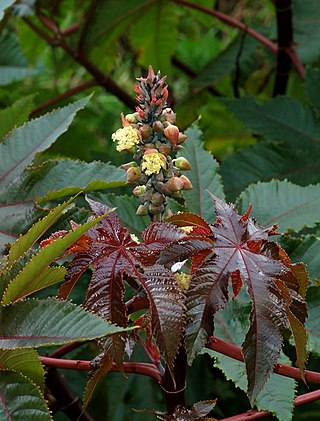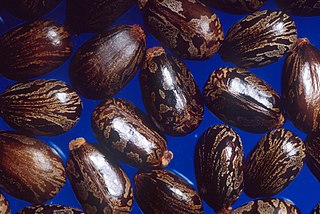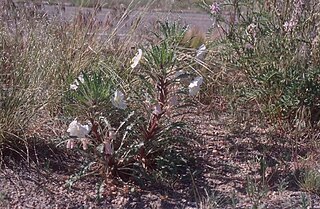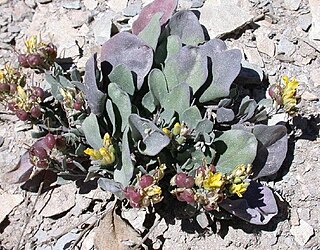Related Research Articles

Ricinus communis, the castor bean or castor oil plant, is a species of perennial flowering plant in the spurge family, Euphorbiaceae. It is the sole species in the monotypic genus, Ricinus, and subtribe, Ricininae. The evolution of castor and its relation to other species are currently being studied using modern genetic tools. It reproduces with a mixed pollination system which favors selfing by geitonogamy but at the same time can be an out-crosser by anemophily or entomophily.

Castor oil is a vegetable oil pressed from castor beans. It is a colourless or pale yellow liquid with a distinct taste and odor. Its boiling point is 313 °C (595 °F) and its density is 0.961 g/cm3. It includes a mixture of triglycerides in which about 90% of fatty acids are ricinoleates. Oleic acid and linoleic acid are the other significant components.

Jatropha curcas is a species of flowering plant in the spurge family, Euphorbiaceae, that is native to the American tropics, most likely Mexico and Central America. It is originally native to the tropical areas of the Americas from Mexico to Argentina, and has been spread throughout the world in tropical and subtropical regions around the world, becoming naturalized or invasive in many areas. The specific epithet, "curcas", was first used by Portuguese doc Garcia de Orta more than 400 years ago. Common names in English include physic nut, Barbados nut, poison nut, bubble bush or purging nut. In parts of Africa and areas in Asia such as India it is often known as "castor oil plant" or "hedge castor oil plant", but it is not the same as the usual castor oil plant, Ricinus communis.

Physaria fendleri is a species of flowering plant in the family Brassicaceae known by several common names, including Fendler's bladderpod, popweed, and lesquerella.

Physaria is a genus of flowering plants in the family Brassicaceae. Many species are known generally as twinpods, bladderpods, or lesquerella. They are native to the Americas, with many species endemic to western North America. They are densely hairy annual and perennial herbs often growing prostrate or decumbent, along the ground in patches or clumps. They bear inflorescences of bright yellow flowers. The fruit is often notched deeply, dividing into twin sections, giving the genus its common name.
Paysonia perforata, known by the common name Spring Creek bladderpod, is a rare species of flowering plant in the mustard family. It is endemic to Tennessee in the United States, where it is known only from Wilson County. This very rare plant is threatened by the loss and degradation of its habitat. It is federally listed as an endangered species.

Lesquerolic acid is a hydroxycarboxylic acid that occurs naturally in Paysonia lasiocarpa and other Paysonia and Physaria species. This compound has the R configuration at the alcohol-bearing stereocenter, and it is of the Z configuration at the olefin. Lesquerolic acid is chemically similar to ricinoleic acid, but with two additional carbons at the carboxyl end of the carbon chain. Lesquerolic acid, with other hydroxy fatty acids, has important industrial uses, including making resins, waxes, nylons and plastics.
Physaria parviflora is a species of flowering plant in the family Brassicaceae known by the common names Piceance bladderpod and frosty bladderpod. It is endemic to Colorado in the United States, where it occurs in Garfield, Mesa, and Rio Blanco Counties.

Paysonia stonensis is a species of flowering plant in the family Brassicaceae, known by the common name Stones River bladderpod. It is endemic to Tennessee in the United States, where it is limited to Rutherford County. It grows only in the floodplains of the Stones River, and certain tributaries.
Physaria fremontii is a species of flowering plant in the family Brassicaceae known by the common name Fremont's bladderpod. It is endemic to Wyoming in the United States, where it occurs only in and around the Wind River Range in Fremont County.

Oenothera harringtonii is a species of flowering plant in the evening primrose family known by the common names Arkansas Valley evening primrose and Colorado Springs evening primrose. It is endemic to the state of Colorado in the United States.
Physaria pallida is a rare species of flowering plant in the mustard family known by the common name white bladderpod. It is endemic to Texas in the United States, where it is known only from San Augustine County. It is federally listed as an endangered species.

Physaria parvula is a species of flowering plant in the family Brassicaceae known by the common name pygmy bladderpod. It is native to the Western United States, where it can be found in Colorado, Utah, and Wyoming.

Physaria pruinosa is a species of flowering plant in the family Brassicaceae known by the common names Pagosa Springs bladderpod and frosty bladderpod. It is native to Colorado and New Mexico in the United States.

Physaria thamnophila is a rare species of flowering plant in the mustard family known by the common name Zapata bladderpod. It is native to Texas in the United States, where it is known from Zapata and Starr Counties. The plant is threatened by the loss and degradation of its habitat. It is federally listed as an endangered species.

Physaria arctica is a perennial flowering herb in the family Brassicaceae, known by the common name arctic bladderpod.
Physaria gordonii, commonly known as Gordon's bladderpod, is a species of plant in the family Brassicaceae distributed throughout the Southwestern United States and Northern Mexico. It is a winter annual wildflower, maturing between April and June. The plant normally grows in sandy or gravel deserts. The plant has low-growing stems, with long, lanceolate leaves measuring about 4 in (10 cm). The plants flowers are in a loose, raceme cluster, and are radially symmetrical. The plant is very similar to P. fendleri.

Physaria ludoviciana is a species of flowering plant in the mustard family Brassicaceae, with the common names of bladder pod, silver bladderpod, louisiana bladderpod, and foothill bladderpod. It used to be Lesquerella ludoviciana which is now a synonym.
References
- ↑ Duke, James A. (1982). "Lesquerella fendleri (A.Gray) S.Wats.". Handbook of Energy Crops. Purdue Center for New Crops.
- 1 2 R. Kleiman (1990). J. Janick; J.E. Simon (eds.). "Chemistry of new industrial oilseed crops". Advances in New Crops. Timber Press, Portland, OR: 196–203. Retrieved 2006-11-19.
- 1 2 Amy Rasberry (April 20, 1998). "Lesquerella pallida - White Bladderpod" . Retrieved 2006-11-19.